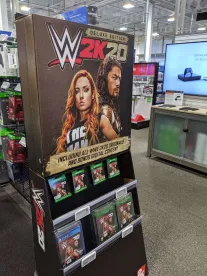Tattoo artist Catherine Alexander (“Alexander”) filed a lawsuit against World Wrestling Entertainment Inc. (“WWE”) and video game maker Take-Two Interactive Software Inc. (“Take-Two”) claiming they violated her intellectual property rights by reproducing her tattoo designs on the digital avatar of wrestling star Randy Orton in a series of released WWE 2K wrestling video games. See Alexander v. Take-Two Interactive Software, Inc., 489 F. Supp. 3d 812 (S.D. Ill. 2020). The lawsuit concerns five designs for which Alexander obtained copyright registrations prior to filing suit.
WWE and Take-Two tried to knockout Alexander’s claims with a motion for summary judgment arguing the WWE 2K video games did not violate Alexander’s copyrights because:
(1) Randy Orton had an implied license to use, distribute, and display his tattoos as part of his “likeness,” which he gave Defendants permission to use;
(2) the use was transformative and therefore exempt from infringement by operation of the fair use doctrine; and
(3) the depiction of Orton’s tattoos in the video game series was de minimis, meaning any similar elements were so trivial that the copying did not rise to the level of actionable substantial similarity.
While the Southern District of New York had granted summary judgment to Take-Two on these grounds in an analogous copyright infringement case involving NBA player tattoos replicated in Defendants’ NBA 2K games, the Southern District of Illinois denied the motion finding triable issues of fact for trial.
The court found triable issues of fact as to the scope, if any, of an implied license for Orton to be able to give others permission to copy Alexander’s tattoo works as part of Orton’s likeness. An implied license is created when
“(1) a person (the licensee) requests the creation of a work,
(2) the creator (the licensor) makes that particular work and delivers it to the licensee who requested it, and
(3) the licensor intends that the licensee-requestor copy and distribute her work.” Effects Assocs., Inc. v. Cohen, 908 F.2d 555, 558 (9th Cir. 1990).
With the first two elements undisputed, the issue for trial will be whether Orton and Alexander discussed permissible forms of copying and distributing the tattoo works and whether any implied license included the right to sublicensing rights.
A viable defense to infringement is when a defendant changes a plaintiff’s copyrighted work or uses the work in a different context such that the plaintiff’s work is transformed into a new creation. 17 U.S.C. § 107; see also Brownmark Films, LLC v. Comedy Partners, 682 F.3d 687, 692-93 (7th Cir. 2012). This is known as “fair use” and applies when a copyrighted work is used for “criticism, comment, news reporting, teaching, scholarship, or research.” Campbell v. Acuff-Rose Music, Inc., 510 U.S. 569, 578 (1994). In determining fair use, a court looks at several non-exhaustive factors: (1) the purpose and character of the use, including whether such use is of a commercial nature or is for nonprofit educational purposes; (2) the nature of the copyrighted work; (3) the amount and substantiality of the portion used in relation to the copyrighted work as a whole; and (4) the effect of the use upon the potential market for or value of the copyrighted work.
Given Defendants copied distinct details of the tattoos, which are prominently displayed and overtly visible in the video games, and the use concerns derivative use and potential licensing rights granted to a copyright holder, the court could not conclude as a matter of law that Defendants’ use was protected “fair use.”
Finally, the Court rejected Defendants’ de minimis argument “that Orton is one of many wrestlers in WWE 2K, that it is difficult to see his tattoos during the videogame, and that the tattoos are a small percentage of the videogame data.” To qualify as de minimis, an infringing use must be “so trivial as to fall below the quantitative threshold of substantial similarity, which is always a required element of actionable copying.” See Ringgold v. Black Entertainment Television, Inc., 126 F.3d 70, 77 (2d Cir. 1997). In those circuits that recognize a de minimis defense, courts evaluate the degree of similarity between the two works, focusing on “whether an average lay observe would recognize the alleged copy as having been appropriated form the copyrighted work,” and considering the amount of the copyrighted work that is copied. The Court, however, found that a de minimis defense is not viable in the Seventh Circuit and precluded Defendants from asserting it at trial.
In contrast to the Southern District of New York’s dismissal based upon these defenses of an infringement case involving NBA player tattoo replicas in acclaimed basketball video games, the Southern District of Illinois was not similarly persuaded and allowed the claims to be tried to a jury, which heard the matter in September 2022. At the conclusion of the case, the jury found the WWE 2K video game developers did not prove “fair use” and awarded Alexander $3,750 in damages to compensate her for actual losses. The jury, however, determined that none of defendants’ profits were attributable to the infringing use and refused to award damages on that score.



 />i
/>i

